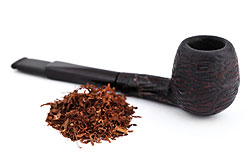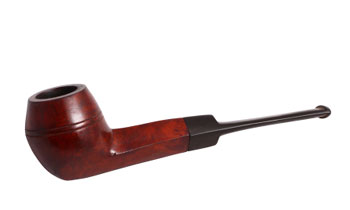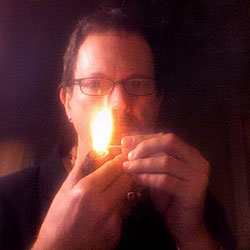G. L. Pease
 I love used pipes ("estate" is the popular euphemism, but let’s call them what they are for today). If I had a great deal more disposable income, the truth is that I’d still probably chase after those old, well-loved beauties with untold histories. I get a good value, the "hard work" of breaking it in has been done, I can add nice examples of pipes that are no longer made to my collection, and if I decide in the future that I don’t want to keep it, I can usually get most, if not all of my money out of it, or even, in some cases, realize a small profit. What’s not to like?
I love used pipes ("estate" is the popular euphemism, but let’s call them what they are for today). If I had a great deal more disposable income, the truth is that I’d still probably chase after those old, well-loved beauties with untold histories. I get a good value, the "hard work" of breaking it in has been done, I can add nice examples of pipes that are no longer made to my collection, and if I decide in the future that I don’t want to keep it, I can usually get most, if not all of my money out of it, or even, in some cases, realize a small profit. What’s not to like?
There’s a potential downside, however, a risk we all take when we buy a pipe someone else is getting rid of. The question, "Why is this amazing pipe finding its way to market?" is a fair one. Usually, I’m reasonably convinced the previous owner simply is moving on. Perhaps they’ve begun collecting a new shape, or another maker, or this piece no longer fits their tastes, or they’re downsizing their collection, or some other completely rational justification for their parting with their gem. All good reasons. But, sometimes, it might be because the pipe just doesn’t smoke well for them.
 I’ve done that—gotten rid of pipes because I didn’t like the way they smoked—and every time, I’ve told the prospective new owner precisely that. "How does it smoke?" Not so well for me, I’ll tell them. In almost every case, though, they’ve come back, thinking me some sort of loony, because to them, the pipe is excellent. Different tobaccos, different body chemistry, different packing and smoking methods, different tastes; any of these could explain why a pipe that simply does not work for one might be superb for another. But, that’s not what I’m really on about, here. Quite.
I’ve done that—gotten rid of pipes because I didn’t like the way they smoked—and every time, I’ve told the prospective new owner precisely that. "How does it smoke?" Not so well for me, I’ll tell them. In almost every case, though, they’ve come back, thinking me some sort of loony, because to them, the pipe is excellent. Different tobaccos, different body chemistry, different packing and smoking methods, different tastes; any of these could explain why a pipe that simply does not work for one might be superb for another. But, that’s not what I’m really on about, here. Quite.
There’s a pipe maker whose work I’ve admired for some time. Budget constraints being what they are, I’ve not been able to find the right and happy confluence of an available pipe and the cash-on-hand to acquire it. Since they don’t appear on the used market often, and generally, the ones that do aren’t quite what I’m after, it was starting to seem unlikely that I’d ever add one to my collection.
That all changed a couple weeks ago, when a striking example showed up on a well-known pipe-seller’s site. It had been smoked heavily, but was still in apparently excellent condition, and was a beautiful representative of the shape I’ve most wanted from this maker. The price was right, so what could I do? I made the call, made the deal, and did the happy dance. (Yes, I still frequently do these things via telephone. There’s something about actually talking to someone who is selling you something that I find comforting, if not downright civilized.) Everything seemed great.
But, what about the disappointment? Wait for it.
The pipe arrived a few days later, and I didn’t even have to open the box to know that I wasn’t exactly going to be ecstatic over what it contained. The smell of heavily sauced aromatic tobacco filled the air as soon as I opened the postbox, as though the hounds of some vanillacoconutmangomelange scented hell had been unleashed with the promise of pounds of flesh and fresh souls to reap. If the box delivered its olfactory assault so perniciously, what manner of terror would the pipe itself visit upon my helpless olfactory senses? (The dealer cleans his wares quite well before shipping. I can only imagine what it must have been like before his ministrations. And, to be completely fair to him, he’d told me of the aroma when I called him, so it really shouldn’t have been such a surprise.)
Clarifying: I’m not as categorically critical of aromatic tobaccos, or those who enjoy them as it may seem. I actually enjoy the aromas of these tobaccos when others smoke them. I’m just, personally, not a fan, haven’t been for a very long time, and don’t find pleasing the intermingling of sweet sauces with the Latakia mixtures I most often smoke. Some people like the so-called "Aromatic English" blends, but I don’t, and I don’t want a pipe turning every bowl I smoke from it into one. For that matter, I’m one of those compulsive sorts who segregates my pipes by tobacco style. Every tobacco leaves its calling card; some don’t care, others don’t notice. I often envy them.
 And, yes, I overreact a bit, sometimes for dramatic effect (if that wasn’t obvious), but even a whiff of anything with more than a slight flavoring can drive me screaming into the next county. To make things worse, I’m cursed with a somewhat over-sensitive sniffer, a condition known as hyperosmia. This anomaly can arguably be of benefit to someone whose livelihood is tied to gustatory and olfactory pleasures, but any advantage it may offer is momentarily, though instantaneously swept away when a pipe I really like turns out to be intolerable to me because of what’s been smoked in it before. I’m overreacting again.
And, yes, I overreact a bit, sometimes for dramatic effect (if that wasn’t obvious), but even a whiff of anything with more than a slight flavoring can drive me screaming into the next county. To make things worse, I’m cursed with a somewhat over-sensitive sniffer, a condition known as hyperosmia. This anomaly can arguably be of benefit to someone whose livelihood is tied to gustatory and olfactory pleasures, but any advantage it may offer is momentarily, though instantaneously swept away when a pipe I really like turns out to be intolerable to me because of what’s been smoked in it before. I’m overreacting again.
So, because of preference and physiology, I’ve always been especially careful with used pipes. In my experience, and others may have a different story to tell, once the wood gets intimate with aromatic sauces for a while, it’s going to be there pretty much eternally. I’ve never had much luck with the ordeal by fire method of purifying these pipes, driving out old daemons by smoking them into submission. Even the activated charcoal and heat technique I developed some years ago doesn’t usually adequately remove enough of the stuff to render the pipe truly "fresh" to my nose. Other strongly flavored tobaccos—Latakia and perique come to mind—leave a trail behind them, as well, but I like those, I smoke those, so their hauntings are not so much of an issue for me, and occasionally, the crossover effects of virginias and Latakia mixtures offer a wonderful surprise. But, a confessed Latakiaphobe and I would likely find ourselves on opposite sides of the Drachma, neither wanting to experience what the other craves, and Vive La Difference!
Back to the box. I briefly considered marking the parcel "Undeliverable – Return to Sender," but my postal carrier knows me, and I’d never get away with it. Besides, curiosity usually gets the best of me.
Still outdoors, I slit the tape, and carefully excavated the pipe from it’s sarcophagus of bubble wrap and packing peanuts. The pipe was everything I’d hoped it would be—and everything I feared. It was a beautiful example of the shape, showing lively grain, deep color, exquisite proportion, balance and weight. It felt great in the hand, and was in excellent condition, having been well cleaned, nicely waxed, and its stem carefully shined. And, it smelled just like the postbox did now, only much stronger, leaving a noticeable sillage (the French word for "wake," and the perfumer’s term for the scent that lingers behind someone wearing a scent) as I walked with it through the house. My nine-year-old noticed. "Daddy, are you wearing some new smelly cologne?" I think he’s inherited my nose.
 One thing that will drive me even harder than curiosity, though, is a good challenge, and this certainly was that. How would I approach it? I couldn’t fill it with activated charcoal and stick it in the oven because of the fancy shank applications. I could send it off to a pipe restorer who has some special voodoo for exorcising these sorts of spectres, but then I’d be without the pipe, my new pipe, for another couple or few weeks, and the thought of that filled me with a minor case of separation anxiety. There didn’t seem to be much point in doing the salt/alcohol treatment, since it had already been done by the seller. I briefly thought about getting some aromatic tobacco, and converting myself, thinking that might be easier than converting the pipe. Nope. Not gonna happen.
One thing that will drive me even harder than curiosity, though, is a good challenge, and this certainly was that. How would I approach it? I couldn’t fill it with activated charcoal and stick it in the oven because of the fancy shank applications. I could send it off to a pipe restorer who has some special voodoo for exorcising these sorts of spectres, but then I’d be without the pipe, my new pipe, for another couple or few weeks, and the thought of that filled me with a minor case of separation anxiety. There didn’t seem to be much point in doing the salt/alcohol treatment, since it had already been done by the seller. I briefly thought about getting some aromatic tobacco, and converting myself, thinking that might be easier than converting the pipe. Nope. Not gonna happen.
All that was left to do, from a practical standpoint, was to fill the pipe with the most potent of Latakia mixtures I had at my disposal, and smoke. For those who have suffered through this far, this is where the redemption part comes in.
The first few puffs were sharply dominated by those same strong vanillacoconutmangomelange aromas, but, as I smoked, they began to dissipate. By the time I’d reached the bottom of the bowl, things had improved dramatically. I could still smell it, still taste it, but not nearly with the hyper-amplified potency that I’d expected from my initial impressions of the pipe’s scent.
Why should this be surprising? We’ve all read dozens of times how others simply "smoke out" whatever has been in the pipe before, but as I mentioned, that just hasn’t been my experience. I’ve smoked a lot of pipes much less tainted by their previous owners that didn’t show nearly so much enthusiasm towards their own recovery, and even after dozens of bowls of "behavior modification," retained their old habits. In fact, a friend had a lovely old Castello that he’d acquired used, and had smoked for several years without eliminating the ghosts of Crunchberries past. I was walking behind him one day, noticing the aroma, and was curious.
"How long have you had that pipe?" I asked.
"Five or six years. Why?"
"Smoke it often?"
"A couple times a week, usually." He looked puzzled.
My next question: "Same tobacco?"
"Not always, but always a virginia." Since he only smoked virginias, I would have figured this one out for myself. I left it at that, filing away another justification to avoid such pipes.
This time, though, with this pipe, inexplicably, I found reason for hope.
I filled the pipe again, and had another bowl. And another. Each was an improvement over the one prior. The following day, some of the aroma returned more noticeably, which is to be expected. The wood can have a tenacious grasp on all those aromatic molecules locked within its fibres, and it’s not going to let go easily. A week later, I’d smoked it ten times, and it was really starting to come to life. The pipe smoked easily every time, effortlessly to the bottom, with no gurgles, no wet heel, no issues at all. Still hopeful.
Tonight, as I type this, I’ve smoked the pipe another dozen times, and though those old poltergeists have not completely dissolved into the mists, they are much more transparent, much less noisy, and I’m enjoying the pipe immensely, my enjoyment probably enhanced by the effort required to get here, and possibly informed by an increased tolerance for the presence of spooks. Was the time spent really so much to ask? If I’d bought the pipe new, I’d just now be starting to find its sweet spot anyway, so maybe it hasn’t been such a travail. Maybe I need to rethink my position on the whole matter.
I’ve said it before: every pipe and every pipe smoker is different, and it’s impossible, or at least naïve, to make sweeping generalizations about anything related to them. If you ask 100 pipesters the same question about pipes and tobacco, you’ll probably get at least 101 answers, and they’ll all be right. Why this one gave up its white-knuckle grip on old ghosts so readily is one of briar’s many mysteries. I find I don’t really need to understand, and that’s probably a good thing, because I’m beginning to think, after 30 years, it isn’t really understandable. According to a friend of mine, briar is a magic substance deposited on the earth by space aliens from another dimension so we could enjoy a good smoke. I think he might be right, and that might partially explain why different smokers have such different reactions to the same pipes and tobaccos. Tonight, though, I’m happy to be enjoying a splendid pipe that I’ve wanted for a long time, and that’s good enough for me.
Your turn.
-glp

Since 1999, Gregory L. Pease has been the principal alchemist behind the blends of G.L. Pease Artisanal Tobaccos. He’s been a passionate pipeman since his university days, having cut his pipe teeth at the now extinct Drucquer & Sons Tobacconist in Berkeley, California. Greg is also author of The Briar & Leaf Chronicles, a photographer, recovering computer scientist, sometimes chef, and creator of The Epicure’s Asylum. |
















As always, this is an excellent article!
Shaun and I are predominantly estate pipe smokers and every pipe has a “personality.” It sounds like your newbie is adaptable to change and I’m happy for you! It would suck if something you had anticipated for so long turned out to not be to your tastes.
Really enjoyed that, good read!
Nice piece, Greg – glad things turned out for you. As a smoker who isn’t super fond of aromatics myself,I was cringing in sympathy at the beginning.
Cyndi, there have been plenty of pipes that weren’t so cooperative, so I’m especially grateful this one was. Thanks for the good wishes.
So, what pipe was this?!?! 🙂
It’s a bit of a poisoned chalice being a “super taster” Greg (actually it’s bit of a bugger but I don’t know if Kevin allows that!); affects wine drinking too?
Not being so gifted/afflicted, I enjoy a pipe from Aaron Spelling’s collection and there is no remaining spectre of Mixture 79. Perhaps with all his pipes it didn’t get a lot of exposure or perhaps there’s some magic in good quality older pipes (you didn’t say how old your acquisition was).
Perhaps as well that we don’t know all the answers (shades of Bronowski again)!
Great read, gives me hope for some estates I have been avoiding for same reasons.
Love this article, Greg. Having “sworn-off” estate pipes some years ago for concerns about remnant flavoring and undisclosed “issues” from ‘bay sellers, I caved in just last week to buy an estate pipe born the year of my birth. Fortunately, the pipe came baptized in familiar odeur, and I’m charmed. Glad it’s working out for you, too.
Greg, my dad left me his modest pipe collection of about 20-30 pipes after he had stopped smoking almost THIRTY years ago. There is one that I gave him as a give when I was in my mid teens,(I’m now 56), a Ben Wade freehand of the very early 70’s. A gorgeous pipe it still is, and I smoke it about a half dozen time a month. I had my eye on it the whole time he owned it. I’d pick it up handle it and imagine myself smoking the gorgeous hunk of fine briar. Dad’s still appreciative that I care for and still honor him by smoking it.
Any how, the first time I fired it up, at the time I was a avid Half and Half smoker, with that now not so good blend, Greg I could taste the Captain Black that he smoked so often, almost Thirty years after he put it down! OMG I couldn’t believe it it. However it was a very friendly ghost. Having Dad along with me like that during my most contemplative times. I did eventually smoke Casper out of it though and it still is an awesome smoke.
Very enjoyable read, as ever. Can’t we have more frequent instalments of your contributions? In this one you may not have managed to change my mind about buying used pipes, but you have offered me a better understanding of how such an acquisition can lead to someone doing a happy dance. I did notice you killed the usual phrase “estate pipe” right from the start, and rightly so. Mortality I don’t need reminding of. But whether he’s dead and buried or not, the previous owner is to me the Mount Everest of objections to ever smoking another man’s pipe. He’d always be there, with every puff and every cleaning and I would be unable to resist giving him some character. Did he have a dog? Where did he take this pipe? What car would he drive? Could we have been friends? His pipe and me, we’d certainly never be really close. That doesn’t stop me from enjoying an article like yours and I sincelery hope your newest member of the family will prove to be all you wished for.
My ghost so far is Ennerdale.
Luckily it haunted my cob, of which I found it very complementing with Virginias, but not so-well with burley.
I think all of us who endeavor to save the estate pipes have a similar story, if not all the same sensory issues. My missus likes to take any box I receive in the mail between November 1st and Christmas, gift wrap it and put it under the Christmas Tree. Well, one time I had an estate pipe that ended up in just such a box. Upon opening it Christmas morn, family and guests were all treated to an awful reek of ancient, uncleaned briar, and old who knows what, that spread across the room like a gallon of spilled milk on a linoleum floor. That old pipe is one of my favorites today, but it took a week to get the smell of it out of the house.
Great tale, my friend, thanks for sharing!
Another excellent and thought provoking article. Bravo, Greg!
Like dukdalf alluded, I think a previously enjoyed pipe is haunted by more than one type of ghost. Very nicely crafted piece of writing, Mr. Pease.
An enjoyable read for sure. But you gave away the ending in the title! A little more mystery next time please Mr. Pease! Haha.
I don’t suppose any one has tried to deodorize their pipe with Baking Powder? Dad used to make me brush my teeth with it lol So it sounds safe for a pipe. Maybe add a bit of water to make a paste, scrub with a toothbrush you’ll never use again, let sit, and see what happens!
But, Spartan, would you have read it had it simply been entitled, “Disappointment?” 😉
And, I think you likely mean baking soda, or sodium bicarbonate. It’s quite good at absorbing odors, but might not help with the smelly molecules within the pipe. The heating/cooling cycles do a pretty good job of stimulating capillary action to move those smells deeper into the wood. This is what inspired my method using activated charcoal and the oven. You can read about that in my Briar & Leaf Chronicles from my own page. I just migrated it there from the old Essays section, so it’s the first article to come up for now.
-glp
The answer to the problem is Ozone. Walker Briarworks is the only one I know that offers the service commercially. The process will kick the wickedest odors out.
As a used pipes buyer and user I had this “poltergeist” problems a lot of times. Finally I developed a method, based on acetone which can remove any kind of ghost from a pipe, even those who have been living on it for decades. Now all my used pipes are “reset” to a like new status prior to start smoking them.
Another quality article that keeps bringing me back – thanks much :)!
And one who doesn’t buy to many “estate” pipes, I love articles like this, so when I delve into the secondary market, I’ll be better informed 🙂 !
Why doesn’t anyone try oil curing for estate pipes like these? If you can safely remove the finish, send it to Jimmy Craig, Randy Wiley, or some industrious pipe repairman willing to give it a try. Just as oil curing drives out the unwanted sap and materials from the briar block before carving, wouldn’t that same process drive out unwanted materials absorbed from smoking?
As always, Greg, very well-written and quite entertaining. I haven’t yet had to bust many ghosts, but it’s nice to know that there is always hope!
Ozone is the answer. Once a pipe sits fully exposed in an ozone chamber it’s as good as new.
Looks like a trip to the walker briarworks ozone chamber would seem to make this a non-issue.
Good piece, as usual. It really makes one — well at least me 😉 –want to know what specific pipe it was…
Every pipe’s an adventure; another wonderful article that will doubtless stir up a new round of controversy on the varied techniques for the exorcism of ghosts!
I had a similar problem with a really nice old patent Dunhill Root bulldog I bought, but it was not nasty tasting from aromatics, but from years of soured English blends. It would hit a point about 2/3 of the way down the smoke where it tasted like burning tires. I had to give it the salt and Everclear treatment twice, and then smoked only Virginia blends in it for a while, and it sweetened up. Some people simply do not take care of their pipes. I use at least 2 and sometimes up to 5 pipe cleaners per smoke, and always take off the stem and clean out the mortise after a smoke. A clean pipe is a happy pipe, and gives you a lifetime of sweet smokes!
Good Article Greg. Let’s here it for “Estate Pipes.”
I’m glad my olfactory sense isn’t as well-developed as yours!
I’ve never had much trouble exorcising an aromatic ghost from a briar, unless they had been used to smoke Lakelands. I don’t do anything but smoke a straight burley through it a few times and I no longer can detect the “crunch berry” effect. But again, I doubt I have anywhere near the sensitivity that you’ve got! As a rule, I bypass most of the mild or even medium-strength blends out there, focusing instead on robust and powerful flavors, such as Odyssey and Haddo’s Delight (either of which could exorcise Peter Blatty’s entire library, IMO).
For all the chemists out there, I find that ethyl acetate will remove almost all of the ester based flavorants. Just dump out the ethyl acetate and cook it in a 200F oven for a few minutes to evaporate the solvent and it is good to go. I would not recommend smoking the pipe until you cook off the solvent though. If it tastes strangely fruity, you didn’t get it all out.
Barling said:
“A clean pipe is a happy pipe”
If there’s one message only I could convey that would be it.
More important than all the brand selection in the world to me; (that’s not to say a clean Charatan doesn’t smoke better than a clean basket pipe).
An enjoyable read for sure. I must admit I have mostly estate pipes, not being in the money bracket that could afford expensive new pipes….I do have some I bought new….
I don’t seem to have the sensitivity of taste that others have, and can smoke these pipes without any bad results, and I have been able to build up a sizable collection for little price,so I guess I’m lucky.
I have briars, rosewood, pearwood, meeschaums,ebony,concobs,calabash,enameled bowls etc, and enjoy smoking all of them.
Believe it or not, one thing I was quite fond of for awhile was to break my pipes in with a healthy amount of aromatics and once that was done, I settled in to smoke my Balkan/Latakia blends from the same pipe. It’s not something I do so much anymore, I guess maybe it was sort of a beginners introduction to the stronger blends, but like you said, ask 100 pipers the same question an you’ll get 101 correct answers.
Thanks for sharing this story, I enjoyed it. Also I agree that one man’s premier tobacco is another man’s “I’ll never buy this again”. We are all different and at the same time similar.
When buying an “estate” pipe, is purchasing a new stem a consideration?
Thank you,
David